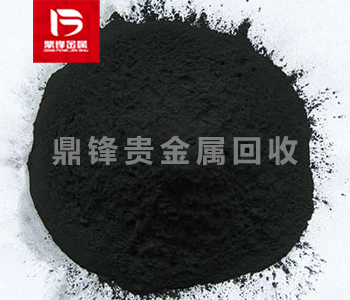
Palladium Powder Recycling
Palladium powder is a small and granular palladium metal powder obtained by special treatment of high-purity palladium metal. It has a gray white appearance, good chemical stability, and high temperature resistance. The preparation of palladium powder is usually achieved through methods such as chemical reduction, thermal reduction, or mechanical grinding, and has the characteristics of high purity and uniform particle size.
- Parameter
- Related Questions and Answers
-
Name : Palladium Powder
-
Use : Catalyst
-
Application Areas : Electronics Industry,Medicine and Biotechnology
-
Appearance and properties : Black powder
-
Settlement Method : On-site Payment
-
Recycling Type : Palladium recycling
-
Door-to-door recycling:worldwide
-
Customer service: Free content testing and door-to-door recycling
Palladium Paste Recycling
Palladium paste is made by mixing palladium powder with binder and solvent. Binders are usually made from materials that bind palladium powder together, while solvents are used to dissolve the binder and create a paste that can be applied to the surface. Once the paste is applied, it is heated to dry and harden. Adhesive is a material that helps paste adhere to the substrate and can be made of various types of polymers or resins. This solvent is used to dissolve the binder and promote the spread of the paste on the substrate. The choice of solvent depends on the type of adhesive used, the viscosity of the required paste, and specific application requirements. Some additives can be added to the formula to improve the performance of palladium slurry. For example, surfactants can be added to increase the wetting ability of the slurry and improve its adhesion performance. Antioxidants can also be added to protect palladium particles from oxidation and improve the stability of the paste.
Search : Palladium Paste RecyclingPalladium Slurry Recycling
Palladium slurry is a fine-grained substance that contains high concentrations of palladium metal particles suspended in a solvent. These palladium particles have nanoscale or submicron size and typically exhibit a gray or black appearance. The preparation process of palladium slurry can be achieved through different methods, the most common of which is chemical synthesis.is a fine-grained substance that contains high concentrations of palladium metal particles suspended in a solvent. These palladium particles have nanoscale or submicron size and typically exhibit a gray or black appearance. The preparation process of palladium slurry can be achieved through different methods, the most common of which is chemical synthesis.
Search : Palladium Slurry RecyclingPalladium(II) Chloride Recycling
Palladium(II) chloride can also be used to wash the metal surface to remove dirt, grease and oil stains, and can also be used to make palladium alloys for the production of palladium Metalloid materials. Due to its high melting point, it can be used to prepare high melting point metal materials, such as for electronic components, automotive parts, medical devices, etc.
Search : Palladium(II) Chloride RecyclingPalladium Catalysts Recycling
A palladium catalyst is a chemical catalyst that uses palladium (Pd) as its active component, typically supported on materials such as alumina, activated carbon, silica, or zeolite. It is widely used in various industries due to its excellent catalytic properties.Recycling methods include acid leaching, solvent extraction, high-temperature smelting, and electrolysis, which allow for the recovery and refining of palladium to a purity of 99.95% or higher.
Search : Palladium Catalysts RecyclingProduct Details
Palladium powder is a small and granular palladium metal powder obtained by special treatment of high-purity palladium metal. It has a gray white appearance, good chemical stability, and high temperature resistance. The preparation of palladium powder is usually achieved through methods such as chemical reduction, thermal reduction, or mechanical grinding, and has the characteristics of high purity and uniform particle size.
1. Catalyst: Palladium powder is widely used as an important component of catalysts. Due to its excellent catalytic activity and selectivity, palladium metal can accelerate chemical reactions and does not participate in the reaction products after the reaction is completed, so it is widely used in catalytic reactions in the chemical industry. For example, palladium powder is commonly used in hydrogenation reactions, carbonylation reactions of olefins, and synthesis of cyclic compounds in organic synthesis.
2. Electronics industry: Palladium powder also has important applications in the electronics industry. It is widely used in the manufacturing of electronic components such as capacitors, resistors, inductors, and printed circuit boards. Palladium powder has become one of the important materials in the electronics industry due to its excellent conductivity and chemical stability, which can provide reliable electronic connections and protection, while having minimal environmental impact.
3. Cosmetics industry: Palladium powder also has certain applications in the cosmetics industry. Due to its excellent antioxidant and antibacterial properties, palladium metal is used as an additive in skincare products. Palladium powder can effectively reduce skin aging, improve skin quality, and inhibit bacterial growth, maintaining skin cleanliness and health.
4. Precious Metal Reserve: Palladium powder, as a precious metal material, is also used as a part of the precious metal reserve. Due to the relatively scarce supply of palladium metal and the increasing demand year by year, palladium powder has become a choice for investors to invest in precious metals. The price of palladium powder is influenced by the supply and demand relationship and the financial market, and has high investment value.
Waste palladium powder is one of the sources of recovery of palladium containing noble metal catalysts. The recovery sources of palladium containing noble metal catalysts include Palladium(II) oxide recovery, Palladium(II) chloride recovery, Palladium(II) nitrate recovery, Palladium(II) bromide recovery, Palladium(II) oxide hydrogen recovery, palladium sulfate recovery, etc. If you have any demand for the recycling of palladium containing precious metal catalyst waste, please call our 24-hour service hotline. Dingfeng Precious Metal Recycling and Refining Factory has its own recycling and refining factory without intermediaries to earn price differences. Our professional technical team and customer service personnel provide one-on-one services to ensure customer privacy during the recycling process.

